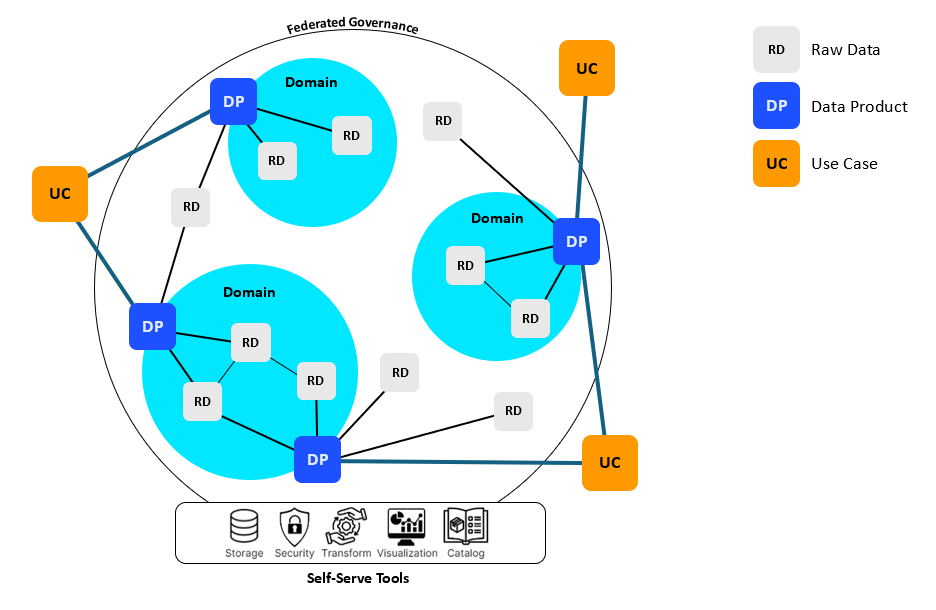The sheer volume of data generated by government entities necessitates efficient, scalable, and secure data management strategies. The concept of a Data Mesh offers a reasonable approach to handling data by promoting a decentralized and domain-oriented architecture. This blog post touches on the intricacies of a Data Mesh and explores its potential implementation within the US Federal Government.
What is Data Mesh?
Data Mesh is a data architecture that moves away from the centralized data lake or warehouse models. It advocates for a decentralized approach where data ownership is distributed across various organizational units. Each domain manages its own data as a product which ensures better quality, governance, and accessibility.
Key Principles of Data Mesh
- Domain-Oriented Decentralized Data Ownership: Data is owned and managed by the domain where it originates. This principle ensures that those who understand the data best are responsible for its quality and availability.
- Data as a Product: Treating data as a product means that data sets are well-documented, discoverable, and maintainable, with clear ownership and service-level agreements (SLAs).
- Self-Serve Data Infrastructure: Empowering domains with the tools and infrastructure they need to manage their data effectively. This infrastructure should be user-friendly, scalable, and secure.
- Federated Computational Governance: Implementing a governance model that ensures compliance and security while allowing domains the autonomy to manage their data.

Data Mesh in the US Federal Government
The US Federal Government handles vast amounts of data across numerous agencies, departments, and programs. Traditional centralized data management approaches often struggle with scale, agility, and timely data access. Data Mesh addresses these challenges by:
- Improving Data Quality: Domain ownership ensures that data is maintained by those with the most knowledge and expertise.
- Enhancing Agility: Decentralized management allows for quicker responses to changes and innovations within individual domains.
- Scalability: The federated model can easily scale with the growing data demands of various government agencies.
- Better Governance: A federated governance approach ensures compliance and security while allowing flexibility.
Implementing Data Mesh in the US Federal Government
Step 1: Establish a Strategic Vision
A clear strategic vision is essential for a successful Data Mesh implementation. This vision should outline the goals, benefits, and expected outcomes of adopting a Data Mesh architecture. Key stakeholders across government agencies must be engaged to ensure alignment and commitment.
Step 2: Identify and Define Domains
Identify the various domains within the government agencies. Domains could be based on departments, programs, or specific functions (e.g., healthcare, finance, transportation). Each domain should have clear ownership and responsibilities.
Step 3: Build Self-Serve Data Infrastructure
Develop and deploy a self-serve data infrastructure that allows domains to manage their data independently. This infrastructure should include tools for data ingestion, storage, processing, and analytics. Technologies such as cloud platforms, containerization, and microservices can play a crucial role.
Step 4: Implement Data Product Principles
Encourage domains to treat their data as products. This includes:
- Documentation: Comprehensive documentation of data sets, including metadata and usage guidelines.
- Discoverability: A data catalog that allows users to discover and access data products easily.
- Service-Level Agreements (SLAs): Clear SLAs for data availability, quality, and support.
Step 5: Federated Computational Governance
Establish a federated governance model that balances autonomy and compliance. This model should include:
- Standards and Policies: Defining data standards, security policies, and compliance requirements.
- Automation: Using automated tools for monitoring, auditing, and enforcing governance policies.
- Collaboration: Facilitating collaboration between domains to share best practices and resolve issues.
Step 6: Continuous Improvement and Innovation
Encourage a culture of continuous improvement and innovation. Regularly review the Data Mesh implementation, gather feedback, and make necessary adjustments. Promote innovation by allowing domains to experiment with new technologies and approaches.
Case Study
Hypothetical Implementation in the Department of Health and Human Services (HHS)
To illustrate the implementation of a Data Mesh, let’s consider a hypothetical scenario within the Department of Health and Human Services (HHS):
Domain Identification
- Public Health: Manages data related to public health initiatives, disease control, and health statistics.
- Healthcare Services: Handles data from healthcare providers, insurance programs, and patient care.
- Research and Development: Focuses on data from clinical trials, medical research, and innovation projects.
Self-Serve Infrastructure: HHS deploys a cloud-based infrastructure with tools for data ingestion, processing, and analytics. Domains can independently manage their data pipelines and analytical workloads.
Data as a Product: Each domain within HHS treats its data as a product. Public Health creates comprehensive documentation and metadata for disease control data sets, ensuring discoverability and usability. SLAs are defined for data availability and quality.
Federated Governance: HHS establishes a federated governance model. Standards for data security and privacy are defined, and automated tools monitor compliance. Collaboration platforms facilitate knowledge sharing between domains.
Continuous Improvement: HHS regularly reviews its Data Mesh implementation, gathers feedback from domain teams, and iterates on its strategy. Innovation is encouraged through pilot projects and hackathons.
Conclusion
Implementing a Data Mesh within the US Federal Government offers a transformative approach to data management. By decentralizing data ownership, treating data as a product, and establishing a robust self-serve infrastructure, government agencies can achieve better data quality, agility, and scalability. With a federated governance model, compliance and security are maintained while allowing domains the flexibility to innovate and respond to their unique data needs.
Implementing a Data Mesh is a collaborative and iterative process that requires commitment and engagement from all stakeholders. As the US Federal Government embraces this new paradigm, it can unlock the full potential of its data and drive better decision-making and public service outcomes.




